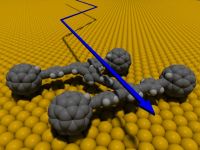Presenting: The World's Smallest Car
Chattahbox.com reports that a professor of chemistry at Rice University has created a car slightly wider than a strand of DNA. Jame Tour’s nanovehicle is 3nm along and 2nm wide. “It rolls on buckyballs, which consist of 60 atoms pure carbon formed like a sphere, includes a chassis with an engine, a pivoting suspension.” Sweet ride! I mean, it does move, right? Absotinylutely! “By heating the surface that the cars are on, the team is able to excite the molecules in the vehicle, and they move forward in a straight line until they hit an object. [Are you in good hands?] The light motion works on the principle of photo activation.” But don’t get to thinking that this bad boy is ready for prime time. “They are manufactured in a 20-step process similar to the way many drugs are synthesized from small molecules in closed reactors. They are then suspended in toluene gas and spun cast onto the gold surface… it took Tour and his team eight years to build the car. One of the significant challenges was attaching the wheels because the buckyballs had the adverse affect of shutting down the binding property — the palladium reaction — used to form the rest of the vehicle.” Don’t you hate it when that happens?
More by Robert Farago


































Comments
Join the conversation
The sad fact of the matter is that in today's credit market, there are few strands of DNA that could hope to finance the purchase of a new nanovehicle.
Mike66Chryslers, I haven't watched Star Trek in years. A lot of silliness, but you can easily Google up the areas of futurism where they were (frighteningly) spot-on. Remember when 'Jurrasic Park' came out? The upright scientists brigade said it could never happen. Or certainly not in a hundred years. Well, oops. They've sequenced Wooly Mammoth. No amber required, just some fur and shampoo. They'll grow one someday soon, just depends on who ponies up. Probably won't work out perfectly, but it will happen. Self-replication is the money shot for nanotech. The basics are semi-drilled down, the rest is just a matter of time. Depending on funding, 5 maybe 10 years.
I think this is amazing. Sometimes we have to create something with no purpose for the sake of artistic creation.
When it hits Seattle, the Scream Greens will demand steel wheels and tracks so it screws up the traffic for everybody else.